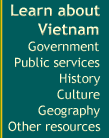There have been many theories regarding the origin of the
Vietnamese language. The most persuasive one argues that the
Vietnamese language previously belonged to the Mon-Khmer
group of the Southeast Asian linguistic system, it was later
transformed into Viet-Muong language (or old Vietnamese
language) and then separated to form the modern Vietnamese
language. In the present-day Vietnamese language, many words
have been proved to contain Mon-Khmer roots and to be
phonetically and semantically relevant to the Muong language.
Throughout a millennium of Chinese domination and under the
Vietnamese feudal dynasties, the official language was the Han, but
the Vietnamese always demonstrated its strength for
self-preservation and development. The Han language was
pronounced in the Vietnamese way, called the Han-Viet way of
pronunciation, and Vietnamized in various ways to create many
commonly used Vietnamese words. The diverse development of the
Vietnamese language brought about the birth of a system of writing
scripts transcribing the Vietnamese language on the basis of the
Han
characters in the 13th century, called the Nom character.
Under the French domination, Han characters were gradually
eliminated and replaced by French that was used in administrative,
educational and diplomatic languages. Thanks to the National
language that boasts the advantages of simple figure, composition,
spelling and pronunciation the modern Vietnamese prose was
actually formed and then accepted positive influence from the
Western cultural language. The National language characters were
produced by some Western evangelists including Alexandre de
Rhodes; they cooperated with some Vietnamese to transcribe the
Vietnamese language on the basis of the Latin alphabet for using in
evangelism in the 17th century. The National language characters
were completed and popularized to become a significant cultural
tool. In late 19th century, publications were published in the
National language characters.
After the August 1945 Revolution, the Vietnamese language and the
National language characters have seized a dominating position and
strongly developed and established itself as a multi-functional
language that has been used in every field, every educational level
and has reflected every reality of life. Today, thanks to the
Revolution, some ethnic minority groups have their own writing
scripts.
The Vietnamese language is characterized by mono-phonology with
a concrete, abundant, acoustic and imaginary vocabulary and a
proportionate, rhythmical, lively, flexible, symbolic and emotional
way of expression, which tremendously facilitates artistic and
literary creation. The Vietnamese dictionary published by the Center
of Lexicography in 1997 consists of 38,410 entries.











